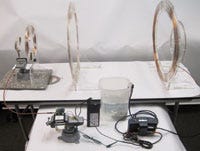August 31, 2011
Dealing with heart disease and the possible need for a heart transplant are extremely stressful ordeals for patients. While ventricular assist devices (VADs) are certainly less traumatic, they nevertheless encumber the heart patient with the discomfort and inconvenience of having a cable protrude from the body. That's where researchers from the University of Washington (UW; Seattle) come in. Determined to free heart disease sufferers from the nearest electrical outlet, they have developed a technology that could eventually enable heart pumps to power and recharge wirelessly.
|
A benchtop prototype of a wireless transmitter-receiver system has the capacity to power and recharge centrifugal pump VADs. |
"The problem we're trying to solve is that VADs consume quite a bit of power--between 5 and 15 W," comments Joshua Smith, UW associate professor of computer science and electrical engineering. "This means that a transcutaneous cable actually comes out the patient's side to bring power and control signals from outside of the body to the inside of the body." As a result, the patient can't bathe, and the protruding cable also poses a substantial risk of infection.
Designed to solve these issues, the UW wireless technology is based on inductive power. It involves a transmitting coil that emits electromagnetic waves at a certain frequency and a receiving coil that absorbs the energy and uses it to charge a battery. "The transmit side is a tuned circuit that has a certain natural frequency," Smith explains. "And the receive side is another tuned circuit with its own natural frequency. When you put them near each other, they interact, and what you end up with is a new kind of combined circuit that actually has two different resonant frequencies."
The transmitter and receiver each have a natural frequency--13 MHz, for example. When they are put together, however, a phenomenon called 'splitting' occurs. The resonant frequency splits, and the combined system has two new resonant frequencies, both of which differ from the original: One is higher than 13 MHz while the other is lower. "The key thing is that as the transmit-to-receive distance changes, the tension resulting from coupling the two sides changes," Smith adds. "This means that the amount of splitting--the difference between the low frequency and the high frequency--increases the more tightly coupled the transmitter and receiver are."
Thus, for every given distance, there is a certain parafrequency at which the system works efficiently, Smith notes. Consequently, if the transmitter can be set to one of the two special frequencies, very high efficiency can be achieved as the transmit-receive distance changes. "That's different from most people's intuition about how wireless power works," Smith says. "Typically your intuition is that the farther away the receiver is from the transmitter, the less power there is. With this technique, if the control system is working correctly to keep the system tuned, the efficiency actually stays constant as the transmit-receive distance changes."
The scientists envision that their power source will contain a small battery that will fill in the gaps between wireless-power areas. For example, if patients want to roam away from the power source, they will be able to wear a vest incorporating a transmitting coil and a battery, Smith says. Instead of power entering the body through a cable, it will be carried via a magnetic field. The transmitting coil, he adds, could conceivably be placed under a bed, a chair, or other common household item.
Using a benchtop prototype of the power source, the researchers have demonstrated proof of concept by successfully powering an LVAD. Their next goal is to conduct animal tests and eventually progress to human trials--a process that can take several years. LVADs are possibly the hardest medical devices to power wirelessly because they consume a great deal of power, Smith comments. "Therefore, if you can power VADs using this technology, it should also be possible to power or recharge pacemaker batteries or any other sort of implantable electronic device."
About the Author(s)
You May Also Like



.png?width=300&auto=webp&quality=80&disable=upscale)